Dry skin on the feet can be uncomfortable and may lead to issues like cracking, itching, and even pain.
A number of steps can be taken:
Moisturize: Apply a thick, hydrating foot cream or lotion daily, especially after bathing or showering. Look for products with ingredients like urea, shea butter, glycerin, or coconut oil, which can help lock in moisture.
Exfoliate: Gently exfoliate your feet to remove dead skin cells. You can use a pumice stone or foot file, or choose a foot scrub with natural exfoliants like sugar or salt. Be careful not to over-exfoliate, as this can worsen dryness.
Soak your feet: Soaking your feet in warm (not hot) water for about 10-15 minutes can help soften the skin. You can add Epsom salts or a few drops of essential oils for a relaxing and moisturizing foot soak.
Avoid hot water: Hot water can strip natural oils from your skin. When washing your feet, use lukewarm water instead.
Use mild soap: Choose a gentle, moisturizing soap or cleanser when washing your feet. Avoid harsh, drying soaps.
Pat dry: After washing or soaking your feet, gently pat them dry with a towel. Avoid rubbing, as this can irritate the skin.
Wear moisture-wicking socks: Opt for socks made of natural, breathable materials like cotton. Avoid synthetic materials that can trap moisture and exacerbate dryness.
Choose the right footwear: Wear shoes that provide good support and allow your feet to breathe. Avoid excessively tight or ill-fitting shoes, as they can cause friction and lead to dry, cracked skin.
Stay hydrated: Proper hydration is crucial for healthy skin. Drink enough water throughout the day to keep your skin hydrated from within.
Consider a humidifier: If you live in a dry climate or use central heating, a humidifier can add moisture to the air and help prevent your skin from drying out.
Foot masks: Consider using hydrating foot masks or overnight treatments. These can provide intense moisture to your feet.
